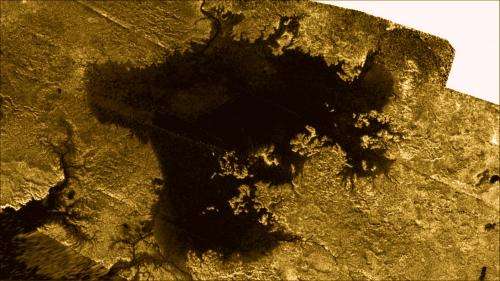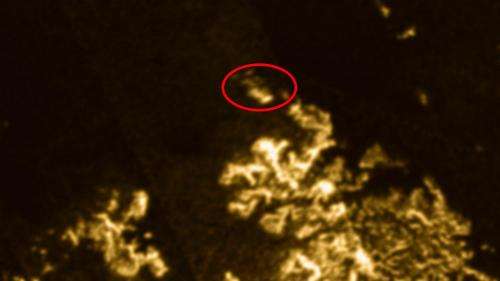Titan's methane cycle is strikingly similar to Earth’s hydrologic cycle and the only other one known to include stable bodies of surface liquids, such as this north polar sea Ligeia Mare. The Cassini mission has characterized Titan’s surface liquid inventory and Ligeia Mare is now known to have a mixed composition of methane, ethane, and dissolved nitrogen. The sea appeared quiescent throughout the 90 Kelvin north polar winter, but on July 10th, 2013 transient features were discovered. Dynamic phenomena are expected to occur with increased frequency and intensity as the 2017 northern summer solstice approaches and will afford Cassini the opportunity to begin characterizing the nature of energetic processes in these alien seas. This image has been modified for aesthetic appeal and is shown in false colour. Credit: NASA/JPL-Caltech/ASI/Cornell
Now you don't see it. Now, you do. And now you don't see it again. Astronomers have discovered a bright, mysterious geologic object – where one never existed – on Cassini mission radar images of Ligeia Mare, the second-largest sea on Saturn's moon Titan. Scientifically speaking, this spot is considered a "transient feature," but the astronomers have playfully dubbed it "Magic Island."
Reporting in the journal Nature Geoscience June 22, the scientists say this may be the first observation of dynamic, geological processes in Titan's northern hemisphere. "This discovery tells us that the liquids in Titan's northern hemisphere are not simply stagnant and unchanging, but rather that changes do occur," said Jason Hofgartner, a Cornell University graduate student in the field of planetary sciences, and the paper's lead author. "We don't know precisely what caused this 'magic island' to appear, but we'd like to study it further."
Titan, the largest of Saturn's 62 known moons, is a world of lakes and seas. The moon – smaller than our own planet – bears close resemblance to watery Earth, with wind and rain driving the creation of strikingly familiar landscapes. Under its thick, hazy nitrogen-methane atmosphere, astronomers have found mountains, dunes and lakes. But in lieu of water, liquid methane and ethane flow through riverlike channels into seas the size of Earth's Great Lakes.
To discover this geologic feature, the astronomers relied on an old technique – flipping. The Cassini spacecraft sent data on July 10, 2013, to the Jet Propulsion Laboratory at the California Institute of Technology for image processing. Within a few days, Hofgartner and his colleagues flipped between older Titan images and the newly processed pictures for any hint of change. This is a long-standing method used to discover asteroids, comets and other worlds. "With flipping, the human eye is pretty good at detecting change," said Hofgartner.
Region of the transient features before they were discovered. Transient features are not present. This image was acquired by the Cassini RADAR system on April 26th, 2007. It has been modified for aesthetic appeal and is shown in false colour. Credit: NASA/JPL-Caltech/ASI/Cornell
Prior to the July 2013 observation, that region of Ligeia Mare had been completely devoid of features, including waves.
Titan's seasons change on a longer time scale than Earth's. The moon's northern hemisphere is transitioning from spring to summer. The astronomers think the strange feature may result from changing seasons.
In light of the changes, Hofgartner and the other authors speculate on four reasons for this phenomenon:
Transient features in Ligeia Mare, circled in red. This image was acquired by the Cassini RADAR system on July 10th, 2013. It has been modified for aesthetic appeal and is shown in false colour. Credit: NASA/JPL-Caltech/ASI/Cornell
- Northern hemisphere winds may be kicking up and forming waves on Ligeia Mare. The radar imaging system might see the waves as a kind of "ghost" island.
- Gases may push out from the sea floor of Ligeia Mare, rising to the surface as bubbles.
- Sunken solids formed by a wintry freeze could become buoyant with the onset of warmer temperatures during the late Titan spring.
- Ligeia Mare has suspended solids, which are neither sunken nor floating, but act like silt in a terrestrial delta.
Region of the transient features after they were discovered. Transient features are not present. This image was acquired by Cassini VIMS on July 26th, 2013. It has been modified for aesthetic appeal and is shown in false colour. Credit: NASA/JPL-Caltech/ASI/University of Arizona/Cornell
"Likely, several different processes – such as wind, rain and tides – might affect the methane and ethane lakes on Titan. We want to see the similarities and differences from geological processes that occur here on Earth," Hofgartner said. "Ultimately, it will help us to understand better our own liquid environments here on the Earth."
More information: Nature Geoscience DOI: 10.1038/ngeo2190
Journal information: Nature Geoscience
Provided by Cornell University


























